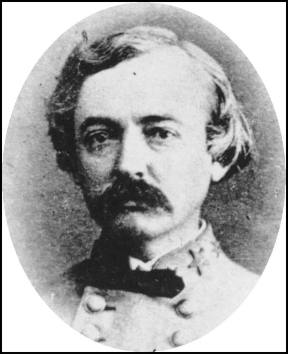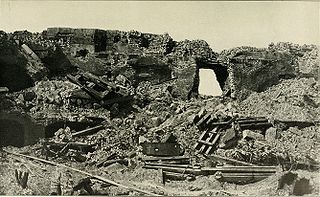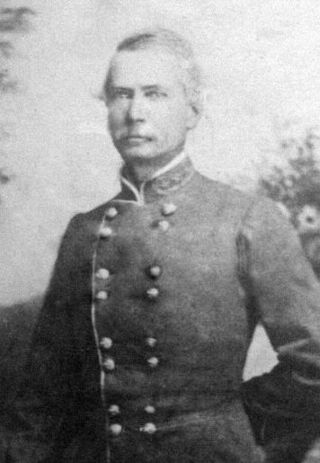The following Confederate Army units and commanders fought in the Siege of Charleston Harbor of the American Civil War. The Union order of battle is listed separately.
The following lists contain the commanders and units [1] involved in the operations against Charleston Harbor from July to September 1863. The first phase from July 10–18 includes the initial engagements at First Fort Wagner, Grimball's Landing and Second Fort Wagner. The second phase from July 19-September 8 includes siege operations against Charleston Harbor and Fort Sumter.
| Division | Post | Regiments and Others |
|---|---|---|
First Sub-Division "James Island" Col Charles H. Simonton until 10 July | Secessionville |
|
| Clark House |
| |
| West James Island |
| |
| Fort Pemberton |
| |
| Fort Lamar |
| |
| Fort Johnson |
| |
| Fort Glover |
| |
| Batteries Haig and Palmer |
| |
| East James Island |
| |
| Cavalry |
| |
2nd Sub-Division | Fort Moultrie |
|
| Battery Bee |
| |
| Battery Marshall |
| |
| Battery Beauregard |
| |
| Palmetto Battery |
| |
| Christ Church |
| |
| Mount Pleasant |
| |
Third Sub-Division "Morris Island" Col Robert F. Graham 9-12 July | Battery Mitchell "Oyster Point" |
|
| Battery Wagner [4] |
| |
| Battery Gregg [5] |
| |
Fourth Sub-Division "Inner Harbor" Col Alfred M. Rhett | Fort Sumter |
|
| Castle Pinckney and Fort Ripley
|
| |
| Charleston |
|
Gen Pierre G. T. Beauregard [6]
| Division | Brigade | Regiments and Others |
|---|---|---|
First Sub-Division | Infantry |
|
| Cavalry |
| |
| Artillery |
| |
| Anderson's Brigade
|
| |
| Hagood's Brigade |
| |
Second Sub-Division | Infantry |
|
| Cavalry |
| |
| Artillery |
| |
| Evans' Brigade |
| |
Harbor Forts | Fort Sumter
|
|
| Castle Pinckney and Fort Ripley |
| |
Charleston | Infantry |
|
| Cavalry |
| |
| Artillery |
| |
| Sailors |
| |
Reserve | St. Andrew's Parrish
|
|
The commanders of Morris Island, scene of the majority of fighting, proved to be ever fluctuating. The following is a list and dates of the officers who commanded Morris Island during the campaign.
| Commander | Dates |
|---|---|
| Col Robert F. Graham | 9-12 July |
| BG William B. Taliaferro | 13-18 July |
| BG Johnson Hagood | 19-22 July |
| BG William B. Taliaferro | 23-25 July |
| BG Alfred H. Colquitt | 26-27 July |
| BG Thomas L. Clingman | 28 July-1 August |
| Col Lawrence M. Keitt | 2-5 Aug |
| BG Johnson Hagood | 6-10 Aug |
| Col George P. Harrison | 11-15 Aug |
| Col Lawrence M. Keitt | 16-21 Aug |
| BG Johnson Hagood | 22-27 Aug |
| BG Alfred H. Colquitt | 28 Aug-3 September |
| Col Lawrence M. Keitt | 3-7 Sept |

The Battle of Fort Sumter was the bombardment of Fort Sumter near Charleston, South Carolina by the South Carolina militia. It ended with its surrender by the United States Army, beginning the American Civil War.

John Clifford Pemberton was a career United States Army officer who fought in the Seminole Wars and with distinction during the Mexican–American War. He resigned his commission to serve as a Confederate lieutenant-general during the American Civil War. He led the Army of Mississippi from December 1862 to July 1863 and was the commanding officer during the Confederate surrender at the Siege of Vicksburg.

Stephen Dill Lee was an American officer in the Confederate Army, politician, and first president of Mississippi State University from 1880 to 1899. He served as lieutenant general of the Confederate States Army in the Eastern and Western theaters of the American Civil War.

Richard Heron Anderson was a career U.S. Army officer, fighting with distinction in the Mexican–American War. He also served as a Confederate general during the American Civil War, fighting in the Eastern Theater of the conflict and most notably during the 1864 Battle of Spotsylvania Court House. Anderson was also noted for his humility.

The First Battle of Fort Wagner was fought on July 10 and 11, 1863, on Morris Island in Charleston harbor during the American Civil War. An attempt by the Union Army to capture Fort Wagner was repulsed. The more famous Second Battle of Fort Wagner, which involved an assault by the 54th Massachusetts, would be fought on July 18.

The Second Battle of Fort Wagner, also known as the Second Assault on Morris Island or the Battle of Fort Wagner, Morris Island, was fought on July 18, 1863, during the American Civil War. Union Army troops commanded by Brig. Gen. Quincy Gillmore launched an unsuccessful assault on the Confederate fortress of Fort Wagner, which protected Morris Island, south of Charleston Harbor. The battle came one week after the First Battle of Fort Wagner. Although a Confederate victory, the valor of the Black Union soldiers in the battle was hailed, which had long-term strategic benefits in encouraging more African-Americans to enlist allowing the Union to employ a manpower resource that the Confederacy could not emulate for the remainder of the war.

Thomas Fenwick Drayton was a planter, politician, railroad president, slave owner and military officer from Charleston, South Carolina. He served in the United States Army and then as a brigadier general in the Confederate States Army during the American Civil War. His brother, Percival Drayton, was a Naval Officer and fought on the Union side during the war.

William Henry Chase Whiting was a United States Army officer who resigned after 16 years of service in the Army Corps of Engineers to serve in the Confederate States Army during the American Civil War. He was wounded at the Second Battle of Fort Fisher by a musket ball to his leg, and died in prison camp on March 10, 1865, of dysentery.

The Second Battle of Fort Sumter was fought on September 8, 1863, in Charleston Harbor. Confederate General P. G. T. Beauregard, who had commanded the defenses of Charleston and captured Fort Sumter in the first battle of the war, was in overall command of the defenders. In the battle, Union forces under Major General Quincy Gillmore attempted to retake the fort at the mouth of the harbor. Union gunners pummeled the fort from their batteries on Morris Island. After a severe bombing of the fort, Beauregard, suspecting an attack, replaced the artillerymen and all but one of the fort's guns with 320 infantrymen, who repulsed the naval landing party. Gillmore had reduced Fort Sumter to a pile of rubble, but the Confederate flag still waved over the ruins.

Roswell Sabine Ripley was an officer in the United States Army during the Mexican–American War, a brigadier general in the Confederate States Army during the Civil War. He was also an author and a prosperous South Carolina businessman.
The following Confederate States Army units and commanders fought in the Battle of Cold Harbor of the American Civil War. The Union order of battle is listed separately. Order of battle compiled from the army organization during the battle and the reports.

The Second Battle of Charleston Harbor, also known as the siege of Charleston Harbor, siege of Fort Wagner, or Battle of Morris Island, took place during the American Civil War in the late summer of 1863 between a combined U.S. Army/Navy force and the Confederate defenses of Charleston, South Carolina.

The First Battle of Charleston Harbor was an engagement near Charleston, South Carolina that took place April 7, 1863, during the American Civil War. The striking force was a fleet of nine ironclad warships of the Union Navy, including seven monitors that were improved versions of the original USS Monitor. A Union Army contingent associated with the attack took no active part in the battle. The ships, under command of Rear Admiral Samuel Francis Du Pont, attacked the Confederate defenses near the entrance to Charleston Harbor. Navy Department officials in Washington hoped for a stunning success that would validate a new form of warfare, with armored warships mounting heavy guns reducing traditional forts.

Robert Ogden Tyler was an American military officer in the Union Army during the American Civil War. He graduated from the United States Military Academy in 1853 and fought in the Yakima War and the Utah War. He commanded the Artillery Reserve in the Army of the Potomac at the Battle of Gettysburg in July 1863, where his artillery batteries played an important role in the Union victory. Tyler also led a division of heavy artillery turned infantry during the Overland Campaign in 1864. He was severely wounded at the Battle of Cold Harbor and served in administrative duties for the remainder of the war.

The Floating Battery of Charleston Harbor was an ironclad vessel that was constructed by the Confederacy in early 1861, a few months before the American Civil War ignited. Apart from being a marvel to contemporary Charlestonians, it was a strategic naval artillery platform that took part in the bombardment of Fort Sumter on April 12 and April 13, 1861, making it the first floating battery to engage in hostilities during the Civil War.

Charles Robert Woods was a career United States Army officer and a Union general during the American Civil War. He is noted for commanding the relief troops that first attempted to resupply Fort Sumter prior to the start of the conflict, and served with distinction during the war.

James Heyward Trapier was a career United States Army officer who fought during the Mexican–American War. He also served as a Confederate general during the American Civil War, dying shortly after its conclusion.
The following Union Army units and commanders fought in the Siege of Charleston Harbor of the American Civil War. The Confederate order of battle is listed separately.

Joshua B. Howell was a Union Army officer during the American Civil War. He served in Southeast Virginia and the Carolinas. He was mortally wounded late in the war following a horse riding accident.

David Bullock Harris was a colonel in the Confederate States Army during the American Civil War. Harris served as an engineer, mostly under the command of General Pierre Gustave Toutant Beauregard. Harris planned and constructed the defenses of Centreville, Virginia, Fort Pillow, Island Number Ten, Vicksburg, Mississippi, Charleston, South Carolina, and Petersburg, Virginia, in the siege of that city's opening phase. He died of yellow fever at Summerville, South Carolina, on October 10, 1864.